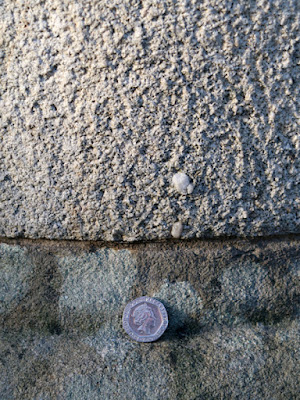 |
| Chatsworth Grit at the gatehouse to Sheffield Botanical Gardens |
Arriving at the Sheffield Botanical Gardens, after photographing some of the historic buildings on Woodbourne Road and Rutland Park for the British Listed Buildings website, I immediately set about my investigation of the stonework used for its buildings. During my last visit, just a week earlier, I had quickly walked through the gardens to photograph its listed buildings, but I didn't stop to have a good look at any of them.
When researching the stone used for the Sheffield Board Schools, which I had been investigating during the previous 9 months, I was interested to see that the SAGT (Sheffield Area Geology Trust) website mentioned that Chatsworth Grit had probably been used for the gatehouse.
Before passing through the gatehouse, I had a quick look at the shaded screen wall to the left of it, where the grey to orange colouration is quite obvious in the large ashlar blocks. Looking closer, the very coarse grained nature of the rock is clearly visible, with subangular pebbles up to 10 mm diameter being very common.
On the south elevation of the gatehouse, the late November sunshine highlighted the high iron content of the stone, with the generally greyish stone assuming a much warmer colour. If the stonework ever needs to be restored, whoever selects a matching coarse sandstone needs to be aware of these changes in the apparent colour of the stone.
An even closer look at the moulded base of one of the very coarse grained Chatsworth Grit columns reveals another variety of gritstone, which is quite grey in colour and has a much finer and more evenly grained texture.
I next stopped very briefly to photograph the Corinthian capitals to two pilasters on the north-east glasshouse which, according to the article on the Building Conservation website - The ‘Paxton’ Pavilions by Joe Rowntree - were replaced during the restoration that was completed in 2003.
A much closer inspection of the entire structure, with my hand lens and stone samples at hand, would have to be undertaken before I could make any further judgement about the potential source of the stone used for the original structure and for subsequent repairs.
The same article goes on to state that Stoke Hall stone from Grindleford has been used for the new planters inside the glasshouses, with Crosland Hill stone from Huddersfield for the flooring – a combination of stones that can also be seen at the Peace Gardens in Sheffield city centre.
I just took a few quick snaps that record some of the interior stonework, without looking at any of the details of the various finishes, especially for the flooring. From my photos, it doesn’t look like it has the same shot-sawn surface as the coarse grained Crosland Hill paving stone seen throughout Sheffield city centre and it may be riven.
In a couple of places, I noticed that rough slabs of siltstone from the Upper Carboniferous Period have been embedded in the planters but, on this occasion, I still had Broomhall to explore and didn’t make any enquiries about these.
 |
| A Stoke Hall sandstone planter and Crosland Hill stone flooring |
In a couple of places, I noticed that rough slabs of siltstone from the Upper Carboniferous Period have been embedded in the planters but, on this occasion, I still had Broomhall to explore and didn’t make any enquiries about these.









No comments:
Post a Comment